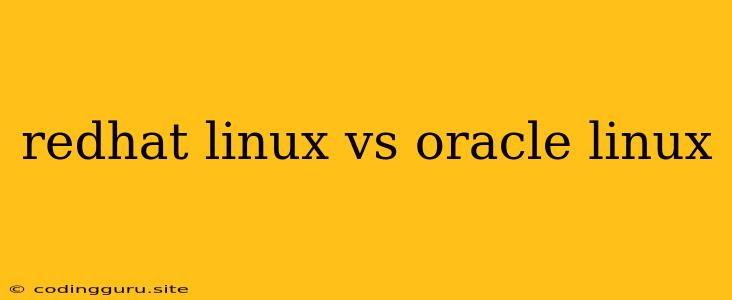Red Hat Linux vs Oracle Linux: Which Distro is Right for You?
Choosing the right Linux distribution can be a daunting task, especially when faced with popular options like Red Hat Linux and Oracle Linux. Both are enterprise-grade distributions built on a solid foundation of stability and security, but they cater to different needs and priorities. This article will delve into the key differences between Red Hat Linux and Oracle Linux, helping you decide which one is the better fit for your specific requirements.
Red Hat Linux: The Enterprise Standard
Red Hat Linux, often shortened to RHEL, is a widely recognized and respected distribution known for its robust enterprise support and extensive ecosystem. Its reputation as a reliable and secure platform has made it a cornerstone of many businesses, particularly in critical infrastructure and mission-critical applications.
Here are some of the key features of Red Hat Linux:
- Long-term support: RHEL offers a long-term support lifecycle, with updates and security patches provided for up to 10 years. This guarantees stability and predictability, making it ideal for applications and systems that require extended support.
- Comprehensive documentation: Red Hat provides an extensive library of documentation, including tutorials, guides, and FAQs, making it easier for administrators to troubleshoot problems and understand the intricacies of the OS.
- Robust ecosystem: RHEL benefits from a vast and vibrant ecosystem of third-party software and hardware vendors, ensuring compatibility and access to a wide range of solutions.
- Strong community support: While primarily focused on enterprise users, Red Hat Linux also has a strong community of developers and users who contribute to its development and provide valuable support.
Oracle Linux: A Free and Open Source Alternative
Oracle Linux is a binary-compatible distribution that closely aligns with Red Hat Enterprise Linux. While it offers a similar level of stability and security, it distinguishes itself by being a completely free and open source offering.
Key characteristics of Oracle Linux:
- Binary compatibility: Oracle Linux is designed to run applications and software compiled for Red Hat Enterprise Linux, minimizing compatibility issues and allowing for seamless migration.
- Free and open source: Unlike RHEL, which requires a subscription for support and updates, Oracle Linux is available for free and open source use, making it an attractive option for budget-conscious users.
- Unbreakable Enterprise Kernel (UEK): Oracle Linux includes the Unbreakable Enterprise Kernel, specifically optimized for performance and stability, especially for critical workloads like databases and enterprise applications.
- Oracle support: While Oracle Linux is free, Oracle offers commercial support packages with dedicated support teams, catering to organizations requiring specialized assistance.
Choosing the Right Distro: Key Considerations
The choice between Red Hat Linux and Oracle Linux ultimately depends on your specific needs and priorities:
Factors favoring Red Hat Linux:
- Enterprise-grade support: If you require long-term support, extensive documentation, and a dedicated support team, RHEL is the preferred option.
- Extensive ecosystem: Its extensive ecosystem of third-party software and hardware vendors guarantees compatibility and access to a broader range of solutions.
- Security and stability: Red Hat is renowned for its commitment to security and stability, crucial for mission-critical applications and sensitive data.
Factors favoring Oracle Linux:
- Cost savings: Oracle Linux is free and open source, making it a more budget-friendly option compared to RHEL, especially for small businesses or individuals.
- Binary compatibility: Its binary compatibility with RHEL simplifies migration and ensures compatibility with existing applications.
- UEK optimization: The Unbreakable Enterprise Kernel provides optimized performance and stability for critical workloads, particularly databases and enterprise applications.
Beyond the Basics: Exploring Other Options
While Red Hat Linux and Oracle Linux are the prominent players in the enterprise Linux space, other alternatives exist. Consider these factors when making your decision:
- **CentOS: ** A community-driven distribution that is 100% compatible with RHEL, offering a free and open source option with a similar level of stability and security.
- Rocky Linux: Another community-driven distribution that strives to maintain full compatibility with RHEL, providing a free and open source alternative with a strong community focus.
Conclusion
The choice between Red Hat Linux and Oracle Linux hinges on your specific needs, budget, and priorities. If you prioritize enterprise-grade support, extensive documentation, and a robust ecosystem, Red Hat Linux is a strong choice. If cost savings, free and open source accessibility, and compatibility with RHEL are your primary concerns, Oracle Linux emerges as a compelling alternative. Remember to carefully consider your requirements and explore the available options before making a decision that best suits your organization's needs.
